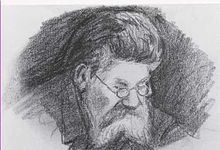Ernst Kirchner
Ernst Kirchner (born April 8, 1847 in Gransee , † February 12, 1921 in Chemnitz ) was a German paper engineer , paper historian and watermark researcher.
Life
Ernst Kirchner was born as the son of the pastor and superintendent Ernst Daniel Martin Kirchner (1802–1879) and his second wife Johanna Auguste Sasse in Gransee near Potsdam and had numerous (half) siblings. In the 1860s he completed a degree in mechanical engineering in Potsdam and Berlin . He then gained practical experience in various paper mills, including a. during a one-year stay in Sweden . In 1873 he secured the first patent for his specially developed fine paper machine. From 1875 to 1878 he modernized the paper mills in Aschaffenburg and Altdamm near Stettin .
From 1879 to 1884 he worked in Aschaffenburg in the white paper factory of the Dessauer family and held the office of “Kgl. Bavarian Steam Boiler Examination Commissioner ”. He was also active as a civil engineer and started a family. He then worked in Frankfurt am Main as an engineer, designer and inventor in the field of paper production. From 1886 to 1889 he was the technical director of the paper mill in Perlen near Lucerne . From 1890 he worked for two years at CG Haubold in Chemnitz as director of the paper department.
From 1892 to 1914 Kirchner was a professor at the Technical Institute and Trade Academy in Chemnitz, today's Chemnitz University of Technology .
Ernst Kirchner was married to the merchant's daughter Maria Elise Franke (1851-1928) and the father of the painter and graphic artist Ernst Ludwig Kirchner , as well as Hans Walter Kirchner and the specialist writer Ulrich Kirchner.
plant
Several important inventions in papermaking go back to Kirchner. He is considered one of the most important authors of the paper industry of his time. He wrote numerous articles in the specialist journal Wochenblatt für Papierfabrikation , which has been published since 1870 and is still published today , of which he was editor from 1892 to 1921. The topics of his own contributions ranged from production-related questions to historical and current trade association topics.
His four-part main work Das Papier summarizes the state of knowledge of papermaking at the time as a historical and systematic representation.
The Ernst Kirchner collection of paper history that he has compiled is in the archive of the Deutsches Museum in Munich .
Fonts (selection)
- The papers of the XIVth century in the city archive Frankfurt a. M. and their watermarks. Jügel, Frankfurt a. M. 1893.
- The paper , Güntter-Staib'sches Wochenblatt. 4 volumes, Biberach 1897–1911 ( digitized version ).
- Teaching and manual of paper manufacture , Güntter-Staib'sches Wochenblatt. 2 volumes, Biberach, 2nd edition 1926.
literature
- † Ernst Kirchner. In: Wochenblatt für Papierfabrikation , Vol. 52, 1921, No. 8, pp. 570-572: 1 portr.
- Albert Haemmerle : Kirchner, Ernst. In: New German Biography (NDB). Volume 11, Duncker & Humblot, Berlin 1977, ISBN 3-428-00192-3 , pp. 657 f. ( Digitized version ).
Individual evidence
- ↑ a b Elisabeth Schröder: The artists of the "Brücke" and their relationship to Aschaffenburg . In: Heinrich Fussbahn (Ed.): Aschaffenburg Yearbook for History, Regional Studies and Art of the Untermaing Area, Volume 30, History and Art Association Aschaffenburg, Aschaffenburg 2014, pp. 262–265.
- ↑ a b Friedrich Naumann: Ernst Kirchner - The Father. In: Ingrid Mössinger, Beate Ritter (Ed.): Ernst Ludwig Kirchner - Die Deutschlandreise 1925/26. From Davos to Frankfurt am Main . Wienand, Cologne 2007, p. 264.
- ^ Weekly paper for paper production . Retrieved April 8, 2018
- ^ Albert Haemmerle : Kirchner, Ernst. In: New German Biography (NDB). Volume 11, Duncker & Humblot, Berlin 1977, ISBN 3-428-00192-3 , pp. 657 f. ( Digitized version ).
- ↑ German Museum . Retrieved March 9, 2020
| personal data | |
|---|---|
| SURNAME | Kirchner, Ernst |
| BRIEF DESCRIPTION | German paper engineer, paper historian and watermark researcher |
| DATE OF BIRTH | April 8, 1847 |
| PLACE OF BIRTH | Gransee |
| DATE OF DEATH | February 12, 1921 |
| Place of death | Chemnitz |

